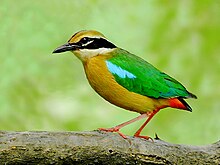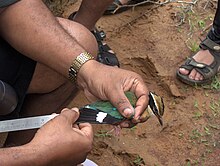Indian pitta
| Indian pitta | |
|---|---|

| |
| Indian pitta in Maharashtra, India
| |
| Scientific classification | |
| Domain: | Eukaryota |
| Kingdom: | Animalia |
| Phylum: | Chordata |
| Class: | Aves |
| Order: | Passeriformes |
| Family: | Pittidae |
| Genus: | Pitta |
| Species: | P. brachyura
|
| Binomial name | |
| Pitta brachyura (Linnaeus, 1766)
| |
| Synonyms | |
|
Corvus brachyurus Linnaeus, 1766[2] | |
The Indian pitta (Pitta brachyura) is a
Taxonomy
The Indian pitta was first known in England after an illustration by an Indian artist was sent by
Etymology
The word 'pitta' is derived from the
Local names in India are based on the colours and behaviours like the time of calling and these include
Description

The Indian pitta is a small stubby-tailed bird that is mostly seen on the floor of forests or under dense undergrowth, foraging on insects in
It is more often heard than seen and has a distinctive loud two-note whistle wheeet-tieu or wieet-pyou or sometimes, a triple note hh-wit-wiyu. They also have a single note-mewing call.[3] They have a habit of calling once or twice, often with neighbouring individuals joining in, at dawn or dusk leading to their common name of "Six-O-Clock" bird in Tamil.[18] When calling the head is thrown back and the bill is pointed upwards.[19]
Pittas are among the few
Distribution and habitat

The Indian pitta breeds mainly in the
Ecology and behaviour
Indian pittas roost in trees.[23] They feed on insects and other small
They breed during the south-west monsoon from June to August, with peaks in June in central India, and in July in northern India.[27] The nest is a globular structure with a circular opening on one side built on the ground or on low branches. It is made up of dry leaves and grasses. The clutch is four to five eggs which are very glossy white and spherical with spots and speckles of deep maroon or purple.[19][23]
Their seasonal movements associated with the rains have not been well studied.[3]
References
- ^ . Retrieved 19 November 2021.
- ^ Dickinson, E. C.; Dekker, R. W. R. J.; Eck, S. & Somadikarta, S. (2000). "Systematic notes on Asian birds. 5. Types of the Pittidae". Zoologische Verhandelingen. 331: 101–119.
- ^ a b c Ali, S.; S. D. Ripley (1983). Handbook of the birds of India and Pakistan. Vol. 4 (2nd ed.). Oxford University Press. pp. 252–253.
- ^ Ray, J.; Derham, W. (1713). "Avium Maderaspatanarum". Joannis Raii Synopsis methodica avium (in Latin). London: Impensis Gulielmi Innys. p. 195.
- ^ Brisson, M. J. (1760). Ornithologie, ou, Méthode contenant la division des oiseaux en ordres, sections, genres, especes & leurs variétés (in French and Latin). Vol. 2. Paris: Jean-Baptiste Bauche. pp. 316–318, Plate 31.
- ^ Edwards, G. (1764). Gleanings of Natural History, Exhibiting Figures of Quadrupeds, Birds, Insects, Plants &c. Vol. 3. London: Printed for the author. p. 242, Plate 324.
- hdl:2246/678.
- ^ Linnaeus, C. (1766). Systema naturae: per regna tria natura, secundum classes, ordines, genera, species, cum characteribus, differentiis, synonymis, locis (in Latin). Vol. Volume 1, Part 1 (Twelfth ed.). Holmiae (Stockholm): Laurentii Salvii. p. 158.
- ^ Traylor, Melvin A. Jr., ed. (1979). Check-list of Birds of the World. Vol. 8. Cambridge, Massachusetts: Museum of Comparative Zoology. p. 324.
- ^ Vieillot, L. J. P. (1816). "137. Brève, Pitta. Corvus Linn. Gm. Lath.". Analyse d'une Nouvelle Ornithologie Élémentaire (in French). Paris: Deterville/self. p. 42, Num. 137.
- ^ Erritzoe, J. (2016). "Indian Pitta (Pitta brachyura)". In del Hoyo, J.; Collar, N. J.; Christie, D. A.; Elliot, A.; Fishpool, L. D. C.; Boesman, P.; Kirwan, G. M. (eds.). Handbook of the Birds of the World and BirdLife International Illustrated Checklist of the Birds of the World. Vol. 2: Passerines. Barcelona, Spain and Cambridge, UK: Lynx Edicions and BirdLife International.
- ^ Newton, A. (1893). "Pitta". A dictionary of birds. London: A. and C. Black. pp. 727–729.
- ^ Jobling, J. A. (2019). "Key to Scientific Names in Ornithology". In del Hoyo, J.; Elliott, A.; Sargatal, J.; Christie, D. A.; de Juana, E. (eds.). Handbook of the Birds of the World Alive. Barcelona, Spain: Lynx Edicions. Retrieved 5 January 2019.
- ^ Anonymous (1998). "Vernacular Names of the Birds of the Indian Subcontinent: 867. Indian Pitta". Buceros. 3 (1): 53–109.
- hdl:2433/110021.
- ^ Prabhakar, A. (1998). "An Indian Pitta (Pitta brachyura) trapped in a standard Sherman live trap". Journal of the Bombay Natural History Society. 95 (1): 114–115.
- ^ Harper, E. W. (1902). "The sex of the Bengal pitta Pitta brachyura". Avicultural Magazine. 1 (1): 29.
- ^ Lambert, F. (1996). "Identification of pittas in the brachyura complex in Asia". OBC Bull. 23: 31–37. Archived from the original on 2008-06-04.
- ^ a b c Whistler, H. (1949). Popular Handbook of Indian Birds (4th ed.). Gurney and Jackson. pp. 275–277.
- .
- ISBN 978-0-7136-6534-5.
- ^ Islam, K. (1978). "Sighting of the Indian Pitta (Pitta brachyura) in Pakistan". Journal of the Bombay Natural History Society. 75 (3): 924–925.
- ^ a b c Rasmussen, P. C.; J. C. Anderton (2005). Birds of South Asia: The Ripley Guide. Smithsonian Institution and Lynx Edicions. pp. 295–296.
- ^ Pande, S. A. (2001). "The Nesting of Pitta brachyura in the Konkan Maharashtra". Newsletter for Birdwatchers. 41 (4): 48–49.
- ^ Singh, H. (2004). "Indian Pitta Pitta brachyura in the Thar Desert". Journal of the Bombay Natural History Society. 101 (2): 319–320.
- ^ Devasahayam, S.; Devasahayam, A. (1989). "A note on the food habits of the Indian Pitta". Newsletter for Birdwatchers. 29 (5&6): 8.
- ^ Bentham, R. M. (1922). "Breeding of the Indian Pitta Pitta brachyura and the Streaked Wren-Warbler Prinia lepida". Journal of the Bombay Natural History Society. 28 (4): 1135.
- PMID 10743858.
- ^ Rajagopalan, P. K. (1972). "Ixodid Ticks (Acarina: Ixodidae) parasitizing wild birds in the Kyasanur forest disease area of Shimoga District, Mysore State, India". Journal of the Bombay Natural History Society. 69 (1): 55–78.
Other sources
- Donald, C. H. (1918). "The occurrence of the Indian Pitta Pitta brachyura in the Kangra District, Punjab". Journal of the Bombay Natural History Society. 25 (3): 497–499.
- Ingalhalikar, S. (1977). "Indian Pitta in captivity". Newsletter for Birdwatchers. 17 (7): 8–9.
- Bolster, R. C. (1921). "Breeding of the Indian Pitta". Journal of the Bombay Natural History Society. 28 (1): 284.

